#Consumer Robotics Trend
Explore tagged Tumblr posts
Text
CES 2025: A Day of Innovation, Resilience, and the Sphere’s Magic
January 7, 2025—The First Day of CES, by Terri Nakamura An Early Start for the Delta Keynote Mornings and I aren’t the best of friends, but today was an exception. At 7 AM, I was up and ready to head to the Las Vegas Convention Center (LVCC) West Hall. Why the early start when doors didn’t open until 10 AM? Delta. After missing out on tickets earlier, I wasn’t taking any chances on securing…

View On WordPress
#CES 2025#Consumer Electronics Show#Delta Air Lines#Delta keynote#Delta Uber Partnership#Delta YouTube Partnership#Ed Bastian keynote#Emerging technology trends#Eureka Park startups#Exosphere LED screen#HOLOPLOT immersive sound#Kara Water technology#Las Vegas Convention Center#Lenny Kravitz#Mixi companion robots#Sustainable innovation at CES#The Sphere Las Vegas#Tom Brady#Viola Davis
0 notes
Text
The Rise of the Machines: A Deep Dive into the Robotic Surgery Consumables Market

Minimally Invasive Surgery has revolutionized healthcare, and Robotic-Assisted Surgery (RAS) is at the forefront of this revolution. With its enhanced precision, improved ergonomics for surgeons, and potential for faster patient recovery, RAS adoption is rapidly increasing.
The landscape of modern surgery is undergoing a profound transformation with the advent of robotic-assisted procedures. As healthcare systems increasingly adopt robotic surgery for its precision, reduced invasiveness, and improved patient outcomes, the demand for consumables essential to these advanced systems is also on the rise.
Understanding Robotic Surgery Consumables
"Robotic Surgery Consumables" refer to the disposable items and accessories used during robotic-assisted surgical procedures. These include instruments like scissors, forceps, staplers, drapes, and trocars, as well as other single-use items necessary for the operation of robotic surgical systems. The high precision and complex nature of robotic surgeries necessitate specialized consumables to ensure safety, sterility, and optimal performance.
According to BIS Research, the Global Robotic Surgery Consumables Market will reach $15.61 billion by 2033 from $4.87 billion in 2023, growing at a CAGR of 12.34% during the forecast period 2023-2033.
Key Market Dynamics
Several factors are driving the growth of the global robotic surgery consumables market:
Increasing Adoption of Robotic Surgery:
- Hospitals and surgical centers rapidly adopting robotic-assisted surgeries
- Benefits include enhanced precision, reduced recovery times, and lower risk of complications
- Growing adoption fuels demand for associated consumables
Technological Advancements in Robotic Systems:
- Continuous advancements in robotic surgery technology
- Improved imaging, real-time data analytics, and enhanced robotic arms
- Need for sophisticated consumables to match advanced systems' capabilities
Rising Prevalence of Chronic Diseases:
- Increasing incidence of chronic conditions (cancer, cardiovascular diseases, obesity)
- Chronic conditions often require surgical intervention
- Boosts demand for robotic surgeries and associated consumables
Aging Population:
- Global aging population leading to a higher number of surgical procedures
- Elderly patients benefit more from minimally invasive surgeries
- Increases use of robotic systems and their consumables
Cost Efficiency and Operational Benefits:
- Robotic systems require significant initial investment
- Offer long-term cost efficiencies through reduced hospital stays and quicker recovery
- Economic advantages promote wider adoption of robotic surgeries and related consumables
Request for a FREE sample research report on Global Robotic Surgery Consumables Market Research!
Global Robotic Surgery Consumables Industry Segmentation
Segmentation by Product Type:
- Instruments and Accessories
- Drapes and Sterilization Consumables
- Other Disposable Items
Segmentation by Application:
- General Surgery
- Cardiothoracic Surgery
- Orthopedic Surgery
- Urology
- Gynecology
- Other Specialized Surgeries
Segmentation by End-User:
- Hospitals
- Ambulatory Surgical Centers (ASCs)
- Specialty Clinics
Want to know more in a much detailed manner on "Navigating the Robotic Surgery Consumables Market Expected to Reach $15.61 Billion by 2033"? Click on the article to explore.
Future Market Prospects
The future of the global robotic surgery consumables market looks promising, with several trends likely to shape its trajectory:
Integration with AI and Machine Learning: The incorporation of AI and machine learning into robotic systems will enhance surgical precision and efficiency, driving the demand for advanced consumables.
Personalized Medicine and Customization: The trend towards personalized medicine will lead to the development of customized surgical consumables tailored to individual patient needs.
Sustainability and Eco-Friendly Solutions: Growing focus on sustainability will drive the development of eco-friendly and biodegradable consumables, reducing the environmental impact of surgical procedures.
Global Adoption and Scalability: As the benefits of robotic surgery become more widely recognized, adoption will scale globally, including in developing regions, contributing to improved surgical outcomes worldwide.
Conclusion
The Global Robotic Surgery Consumables Industry is poised for significant growth, driven by the increasing adoption of robotic surgeries, technological advancements, rising prevalence of chronic diseases, aging population, and cost efficiency. By addressing challenges related to costs, training, and regulatory issues, and leveraging opportunities in technological innovation, emerging markets, training, and collaborations, the potential of robotic surgery consumables in revolutionizing healthcare can be fully realized. This market not only enhances surgical precision and patient outcomes but also contributes to the overall efficiency and sustainability of healthcare systems worldwide.
#Robotic Surgery Consumables Market#Robotic Surgery Consumables Industry#Robotic Surgery Consumables Market Report#Healthcare#BIS Research#Robotic Surgery Consumables Market Research#Robotic Surgery Consumables Market Forecast#Robotic Surgery Consumables Market Trends#Robotic Surgery Consumables Market Analysis
1 note
·
View note
Link
Growing Smart Homes Trend Boosts the Consumer Robotics Market Demand...
#market research future#consumer robotics market#consumer robotics industry#consumer robotics market size#consumer robotics trends
0 notes
Text

Czech Miku at her worst, she is beauty, she is grace, she has spent 3 days on majáles consuming nothing but lukewarm pilsner and langoš and now she has fallen straight on her face.
Breakdown of her design below the cut!
Her hair is badly dyed with schwarzkopf live electric blue dye because thats usualy the only blue you can get here in regular stores without ordering online or looking into specialized stores and usualy winds up being the first unusual dye color people try.
Her shirt being RUR is a refrence to a play by Karel Čapek which coined the term "robot", felt fitting for her as a vocaloid.
Cargo shorts, plaid shirt, fanny pack and socks with sandals are just a must like thats tradition at this point.
Her bag is the rainbow pride bag from flying tiger. Many queer people here just own this bag because its easy to get and looks fun.
Can of caffeine pomelo birel - caffeinated non alcoholic pomelo flavored beer, i'd draw her with a regular pilsner because yeah but i felt like this better showed the deranged shit czech people do with beer for the fun of it
Smažák - deep fried block of cheese with fried and tartar sauce my beloved. Ofc it has to be on a greasy paper plate.
I also put a Pilsen tram card on her belt loop :)
Her hair is meant to be shaped to resemble a lion mane and 2 lion tails as a refrence to the czech lion ☆
Her tattoos are:
(Right arm) Alzák - an alien mascot for a tech seller company alza, known to have am extremely annoying nasaly voice which quickly made him a huge meme. People usualy wanna murder him.
(Left arm) Robot Zajac - a side character from a russian cartoon called Nu pogodi zajac that many people in czechia (including me) grew up with. He's fucked up and i love him.
(Left leg) Linden tree leaf - linden is the national tree
(Right leg) Vodník by Jozef Lada - a czech folk creature guy
Vole cože - "bitch what"
I♡ pórek - "I♡ leek"
Nikam vole - "nowhere fucker"
I love this trend and thought it'd be fun to do my own spin on it :D I live in Pilsen now so i considered drawing her in a Pilsen kroj but i figured i'd have more fun designing her to look like me and my friends :3
683 notes
·
View notes
Text


The Legacy of Genius Built Industries: Exclusive Interview with Othello Von Ryan
transcript and process under the cut




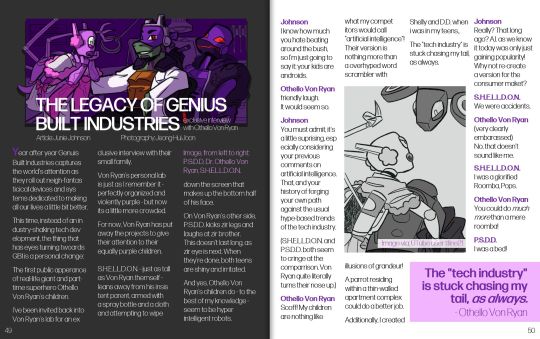
Year after year, Genius Built Industries captures the world's attention as they roll out neigh-fantastical devices and systems dedicated to making all our lives a little bit better.
This time, instead of an industry-shaking tech development, the thing that has eyes turning towards GBI is a personal change: the first public appearance of real-life giant and part-time superhero Othello Von Ryan's children.
I've been invited back into Von Ryan's lab for and exclusive interview with their small family.
Von Ryan's personal lab is just as i remember it - perfectly organized and violently purple - but now it's a little more crowded.
For now, Von Ryan has put away the projects to give their attention to their equally purple children.
S.H.E.L.L.D.O.N. - just as tall as Von Ryan themself - leans away from his insistent parent, armed with a spray bottle and a cloth and attempting to wipe down the screen that makes up the bottom half of his face. On Von Ryan's other side, P.S.D.D. kicks zir legs and laughs at zir brother.
This doesn't last long, as zir eye is next. When they're done, both teens are shiny and irritated.
And yes, Othello Von Ryan's children do - to the best of my knowledge - seem to be hyper-intelligent robots.
Johnson:
I know you hate beating around the bush, so I'm just going to say it: your kids are androids.
Othello Von Ryan:
Friendly laugh. It would seem so.
J:
You must admit, it's a little surprising, especially considering your previous comments on artificial intelligence. That, and your history of forging your own path against the usual hype-based trends of the tech industry.
(S.H.E.L.L.D.O.N. and P.S.D.D. both seem to cringe at the comparison. Von Ryan quite literally turns their nose up.)
OVR:
Scoff! My children are nothing like what my competitors would call "artificial intelligence"! Their version is nothing more than an overhyped word scrambler with illusions of grandeur! A parrot residing within a thin-walled apartment complex could do a better job.
Additionally, I created Shelly and D.D. when I was in my teens. The "tech industry" is stuck chasing my tail, as always.
J:
Really? That long ago? A.I. as we know it today was only just gaining popularity! Why not re-create a version for the consumer market?
S.H.E.L.L.D.O.N.:
We were accidents.
OVR:
(Very clearly embarrassed)
No, that doesn't sound like me.
S:
I was a glorified roomba, Pops.
OVR:
You could do much more than a mere roomba!
P.S.D.D:
I was a bed!
#quarterdraws#teenage mutant ninja turtles#rise of the teenage mutant ninja turtles#rise donnie#rise sheeldon#rise psdd#magazine#mock up#i had so much heckin fun with this one#i was originally going to my the exclusive illustration#but then it was /too good/ you feel#so it became early access and i made another one
291 notes
·
View notes
Text
Just some random thoughts.
I know that numbers and likes don't really matter on social media and when you draw, you mainly draw for yourself but it's funny how seeing people get interested in you stuff makes you want to create more. Yes, perhaps it's short-lasting satisfaction and you should just focus on doing your thing but it still has its impact.
Social media these days are demanding. You have to post certain things at particular time, be everywhere, all the time. People migrate to different sites looking for something better and you need to follow. But I'm too tired. Too tired to manage every site that doesn't even work on my old phone, follow trends, pay attention to the ever-changing algorithm, escape from billionaire idiots, greedy corporations, flesh and mind consuming robots, people that don't care.
So, seeing someone's comment or a spike in interest, seeing real people being really curious about something I created, seeing that someone found me in a pile of trash that's today's internet is a little reminder that posting another drawing or sharing an update about my writing isn't a complete waste of time.
Though I notice how everything changed while I was absent for those couple years and I wonder sometimes if I should maybe stop posting and come back when, or if, I have something really worth showing, a bigger project. Maybe what I have right now isn't good enough to share. And then someone leaves a nice message or more people start to follow my blog and I think: okay, maybe one more drawing, maybe one more writing update.
I know that commenting and showing you care about someone else's projects require energy but I try to do it more often myself. I'm rarely on social media these days because they're exhausting and I suck at commenting but I still try. And I appreciate when people try for me. Thank you guys!
(btw, it's not fishing for attention and engagement, it's just something I thought about lately looking at drawings of my characters that kinda appeared out of nowhere xD)
48 notes
·
View notes
Text
Milton Orr looked across the rolling hills in northeast Tennessee. “I remember when we had over 1,000 dairy farms in this county. Now we have less than 40,” Orr, an agriculture adviser for Greene County, Tennessee, told me with a tinge of sadness.
That was six years ago. Today, only 14 dairy farms remain in Greene County, and there are only 125 dairy farms in all of Tennessee. Across the country, the dairy industry is seeing the same trend: In 1970, more than 648,000 US dairy farms milked cattle. By 2022, only 24,470 dairy farms were in operation.
While the number of dairy farms has fallen, the average herd size—the number of cows per farm—has been rising. Today, more than 60 percent of all milk production occurs on farms with more than 2,500 cows.

This massive consolidation in dairy farming has an impact on rural communities. It also makes it more difficult for consumers to know where their food comes from and how it’s produced.
As a dairy specialist at the University of Tennessee, I’m constantly asked: Why are dairies going out of business? Well, like our friends’ Facebook relationship status, it’s complicated.
The Problem with Pricing
The biggest complication is how dairy farmers are paid for the products they produce.
In 1937, the Federal Milk Marketing Orders, or FMMO, were established under the Agricultural Marketing Agreement Act. The purpose of these orders was to set a monthly, uniform minimum price for milk based on its end use and to ensure that farmers were paid accurately and in a timely manner.
Farmers were paid based on how the milk they harvested was used, and that’s still how it works today.
Does it become bottled milk? That’s Class 1 price. Yogurt? Class 2 price. Cheddar cheese? Class 3 price. Butter or powdered dry milk? Class 4. Traditionally, Class 1 receives the highest price.
There are 11 FMMOs that divide up the country. The Florida, Southeast, and Appalachian FMMOs focus heavily on Class 1, or bottled, milk. The other FMMOs, such as Upper Midwest and Pacific Northwest, have more manufactured products such as cheese and butter.
For the past several decades, farmers have generally received the minimum price. Improvements in milk quality, milk production, transportation, refrigeration, and processing all led to greater quantities of milk, greater shelf life, and greater access to products across the US. Growing supply reduced competition among processing plants and reduced overall prices.
Along with these improvements in production came increased costs of production, such as cattle feed, farm labor, veterinary care, fuel, and equipment costs.
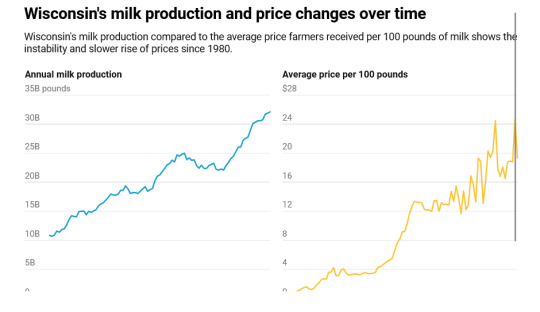
Researchers at the University of Tennessee in 2022 compared the price received for milk across regions against the primary costs of production: feed and labor. The results show why farms are struggling.
From 2005 to 2020, milk sales income per 100 pounds of milk produced ranged from $11.54 to $29.80, with an average price of $18.57. For that same period, the total costs to produce 100 pounds of milk ranged from $11.27 to $43.88, with an average cost of $25.80.
On average, that meant a single cow that produced 24,000 pounds of milk brought in about $4,457. Yet, it cost $6,192 to produce that milk, meaning a loss for the dairy farmer.
More efficient farms are able to reduce their costs of production by improving cow health, reproductive performance, and feed-to-milk conversion ratios. Larger farms or groups of farmers—cooperatives such as Dairy Farmers of America—may also be able to take advantage of forward contracting on grain and future milk prices. Investments in precision technologies such as robotic milking systems, rotary parlors, and wearable health and reproductive technologies can help reduce labor costs across farms.
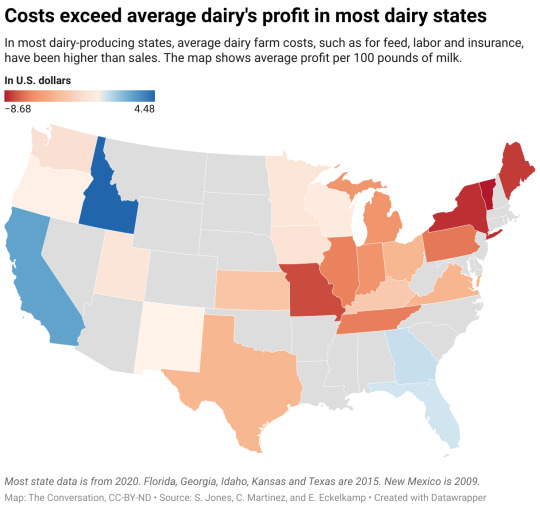
Regardless of size, surviving in the dairy industry takes passion, dedication, and careful business management.
Some regions have had greater losses than others, which largely ties back to how farmers are paid, meaning the classes of milk, and the rising costs of production in their area. There are some insurance and hedging programs that can help farmers offset high costs of production or unexpected drops in price. If farmers take advantage of them, data shows they can functions as a safety net, but they don’t fix the underlying problem of costs exceeding income.
Passing the Torch to Future Farmers
Why do some dairy farmers still persist, despite low milk prices and high costs of production?
For many farmers, the answer is because it is a family business and a part of their heritage. Ninety-seven percent of US dairy farms are family owned and operated.
Some have grown large to survive. For many others, transitioning to the next generation is a major hurdle.
The average age of all farmers in the 2022 Census of Agriculture was 58.1. Only 9 percent were considered “young farmers,” age 34 or younger. These trends are also reflected in the dairy world. Yet, only 53 percent of all producers said they were actively engaged in estate or succession planning, meaning they had at least identified a successor.
How to Help Family Dairy Farms Thrive
In theory, buying more dairy would drive up the market value of those products and influence the price producers receive for their milk. Society has actually done that. Dairy consumption has never been higher. But the way people consume dairy has changed.
Americans eat a lot, and I mean a lot, of cheese. We also consume a good amount of ice cream, yogurt, and butter, but not as much milk as we used to.
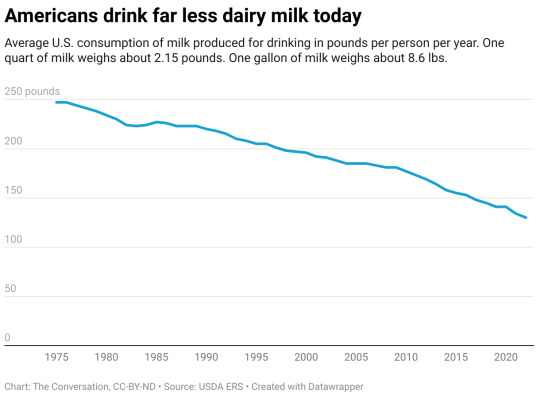
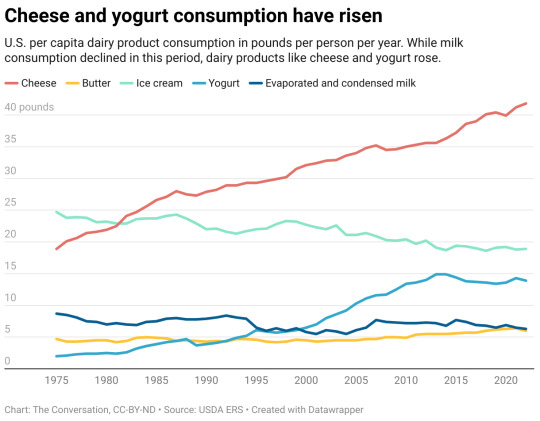
Does this mean the US should change the way milk is priced? Maybe.
The FMMO is currently undergoing reform, which may help stem the tide of dairy farmers exiting. The reform focuses on being more reflective of modern cows’ ability to produce greater fat and protein amounts; updating the cost support processors receive for cheese, butter, nonfat dry milk, and dried whey; and updating the way Class 1 is valued, among other changes. In theory, these changes would put milk pricing in line with the cost of production across the country.
The US Department of Agriculture is also providing support for four Dairy Business Innovation Initiatives to help dairy farmers find ways to keep their operations going for future generations through grants, research support, and technical assistance.
Another way to boost local dairies is to buy directly from a farmer. Value-added or farmstead dairy operations that make and sell milk and products such as cheese straight to customers have been growing. These operations come with financial risks for the farmer, however. Being responsible for milking, processing, and marketing your milk takes the already big job of milk production and adds two more jobs on top of it. And customers have to be financially able to pay a higher price for the product and be willing to travel to get it.
33 notes
·
View notes
Text
Excerpt from this story from Grist:
A growing number of companies are bringing automation to agriculture. It could ease the sector’s deepening labor shortage, help farmers manage costs, and protect workers from extreme heat. Automation could also improve yields by bringing greater accuracy to planting, harvesting, and farm management, potentially mitigating some of the challenges of growing food in an ever-warmer world.
But many small farmers and producers across the country aren’t convinced. Barriers to adoption go beyond steep price tags to questions about whether the tools can do the jobs nearly as well as the workers they’d replace. Some of those same workers wonder what this trend might mean for them, and whether machines will lead to exploitation
On some farms, driverless tractors churn through acres of corn, soybeans, lettuce, and more. Such equipment is expensive, and requires mastering new tools, but row crops are fairly easy to automate. Harvesting small, non-uniform and easily damaged fruits like blackberries, or big citruses that take a bit of strength and dexterity to pull off a tree, would be much harder.
That doesn’t deter scientists like Xin Zhang, a biological and agricultural engineer at Mississippi State University. Working with a team at Georgia Institute of Technology, she wants to apply some of the automation techniques surgeons use, and the object-recognition power of advanced cameras and computers, to create robotic berry-picking arms that can pluck the fruits without creating a sticky, purple mess.
The scientists have collaborated with farmers for field trials, but Zhang isn’t sure when the machine might be ready for consumers. Although robotic harvesting is not widespread, a smattering of products have hit the market, and can be seen working from Washington’s orchards to Florida’s produce farms.
3 notes
·
View notes
Text
An Overview of UK Home Small Domestic Appliances Market: Trends and Insights
The UK home small domestic appliances (SDA) market has seen significant growth driven by evolving consumer lifestyles, technological innovations, and a growing focus on energy efficiency and sustainability. From kettles and toasters to handheld vacuums and smart kitchen gadgets, SDAs are becoming indispensable in UK households.

Buy the Full Report for More Category Insights into the UK Home Small Domestic Appliances Market
Download a Free Sample Report
Here’s an analysis of the key trends and insights shaping the market in 2024.
1. Market Size and Growth
The SDA market in the UK is expected to grow at a CAGR of 4-6% from 2023 to 2028, driven by post-pandemic shifts in home-based lifestyles.
Rising disposable income and increasing interest in premium and smart appliances are fueling demand.
2. Key Consumer Trends
a. Smart and Connected Appliances
Voice control integration (via Alexa, Google Assistant) and IoT-enabled SDAs are gaining traction.
Popular products: Smart kettles, Wi-Fi-enabled coffee makers, and robotic vacuum cleaners.
b. Health and Wellness Focus
Growing interest in air fryers, blenders, and juicers as consumers focus on healthier lifestyles.
Increased demand for air purifiers and humidifiers due to rising concerns over indoor air quality.
c. Sustainability and Energy Efficiency
UK consumers are prioritizing eco-friendly appliances with lower energy consumption, such as energy-efficient kettles and low-wattage irons.
Brands offering repairable and recyclable products are seeing stronger loyalty.
d. Compact and Space-Saving Designs
Urban living and smaller households drive demand for multi-functional and compact SDAs, such as 2-in-1 steamers or combination microwaves.
3. Product-Specific Insights
Kitchen Appliances
Coffee Machines:
Premium brands like Nespresso and De’Longhi dominate, with demand for bean-to-cup and pod-based machines increasing.
Air Fryers:
Brands like Tefal and Ninja lead as air fryers become a household staple.
Consumers prioritize larger capacities and multi-functionality.
Cleaning Appliances
Robotic Vacuum Cleaners:
Growing adoption of smart robotic vacuums from brands like iRobot and Eufy.
Consumers value mapping technologies and self-emptying features.
Handheld Vacuums:
Brands like Dyson continue to dominate the cordless vacuum segment, driven by innovations in battery life and suction power.
Personal Care Appliances
Growth in electric toothbrushes, hair dryers, and grooming kits, driven by brand diversification and targeted marketing.
4. Retail and Distribution Trends
E-commerce Boom:
Online channels like Amazon, Argos, and Currys are witnessing robust growth, fueled by convenience and competitive pricing.
Omni-Channel Experiences:
Retailers are integrating digital and in-store experiences, such as AR demos for products.
Subscription Models:
Brands offering subscription plans for products like coffee machines and vacuum filters are seeing higher customer retention.
5. Competitive Landscape
Key Players
Dyson:
Leader in cordless vacuum and air purifier segments, with a focus on cutting-edge design and functionality.
Ninja:
Dominates the air fryer market and continues to expand into other SDAs like blenders and multi-cookers.
Philips:
Strong presence in personal care and kitchen appliances, with a growing focus on energy efficiency.
Breville:
Known for kettles, toasters, and sandwich makers, with a strong mid-market appeal.
Market Share Dynamics
Premium brands like Dyson and Nespresso dominate the high-end segment.
Mid-range brands (e.g., Tefal, Morphy Richards) maintain steady growth by balancing affordability and quality.
New entrants offering smart or niche eco-friendly solutions are gradually gaining market share.
6. Challenges and Opportunities
Challenges
Economic Pressures:
Inflation and rising energy costs may deter discretionary spending on premium SDAs.
Supply Chain Disruptions:
Component shortages and logistical issues continue to affect manufacturing and delivery timelines.
Opportunities
Sustainability:
Brands investing in energy-efficient and recyclable products are likely to capture eco-conscious consumers.
Customization:
Offering customizable products (e.g., personalized coffee settings or modular vacuum components) can differentiate brands.
7. Future Outlook
Smart Home Integration:
Growth in smart home adoption will drive demand for IoT-enabled SDAs.
Health and Wellness Products:
Continued interest in products supporting healthy lifestyles, such as air purifiers and low-fat cooking appliances.
Sustainability Leadership:
Companies embracing circular economy principles will gain a competitive edge.
The UK small domestic appliances market is poised for steady growth, underpinned by consumer preferences for convenience, sustainability, and technology-driven innovation. Players who align their strategies with these evolving trends will be best positioned to thrive.
2 notes
·
View notes
Text
Reminisce the Past, Forecast the Future
"A traveler can change so as the travel they seek."
A way to escape, a breathable surface to take. Traveling can be fun in more ways: through extreme activities, finding leisure in specific places, wondering around the land of beauty, and capturing scenery. The future opens our eyes, but the past holds our hearts. Looking back at all that we have previously and predicting what the future holds is a way to see that these travel trends are continuously growing and evolving widely by the contribution and effect of the market.
Emerging with technology, the future can be more high-tech in any industry, especially in the tourism field. Some kind of astrotourism or space tourism will be offered where tourists take a peak in outer space. Robots will be introduced and will have a large impact as a travel trend. Automation became widely accepted amidst the pandemic, and even at the end of it, human tasks were taken by this innovation, from service to communicating, where “chatbots” and “jollibots” are one representation. Also, virtual reality tours will continue to grow, as some consumers have already encountered them. Through the lens of this invention, we can witness and be mesmerized by the beauty of a place. The mention of the future is filling us with excitement, but let’s now talk about what we had before we reached this conclusion. Wellness and retreat travel are two of the travel trends that all ages have undergone. They are getaways that you can do alone or in groups. The goal is to take a break, deeply breathe, and focus on setting yourself free. Then comes the entry of travel agencies, where tour packages arise. This made travel easy for travelers; with the use of tour itineraries, brochures, and flyers, all tourist needs are one pack away. Adventure travel is also one, as defined by the word itself: adventurous activities are executed. Last is the educational tour, a popular tour that takes place outside of schools every year.
#travelwritingandphotography #traveltrends
7 notes
·
View notes
Text
BPO Companies: How to Choose the Best BPO Company in India?
Today, business process outsourcing has become a growing trend. With so much data and consumers to manage, corporate confidence in Best BPO Company has grown over the years. India's IT and BPO services sector has grown rapidly since its inception in the mid-1990s and today has a turnover of US$37.6 billion. The Indian BPO market has grown due to economies of scale, reduced business risk, cost advantages, improved utilization, and superior experience. Among competitors such as Australia, China, the Philippines, and Ireland, India is now the world's leading hub for the consumption of BPO services. India's immense popularity as a global outsourcing destination is due to the country's low labor costs and a large pool of skilled and skilled workers gave an opportunity to companies like Ascent BPO to provide better services at reasonable prices.
But since many organizations in India offer quality data entry services, companies only need to choose the best ones after they have done their homework. Look on our website to learn how to choose the Best BPO Company like us.
What is business process deploying or outsourcing (BPO)?
Before we get started, we want to give our audience an overview of what a BPO is. Business process outsourcing companies provide services that allow companies to focus on their core business. Let us consider this problem in detail. You may not have the time or resources for a separate organization that you can trust to handle other aspects of your business. These other aspects can be anything from call center operations, marketing, SEO, finance to human resource activities. The sky is the limit. Now that business process outsourcing has sparked some interest, let's explain what to look for in the Best BPO company.
Some Best BPO company are given below:
Tata Consulting Services:
Tata Consulting Services (TCS) is the second-best outsourcing firm in India. TCS is an organization based in Mumbai in Bangalore. TCS provides trading services, platform solutions, analytics, information services, and more. TCS has more than 400,000 employees in India and thousands of employees in other parts of the world. Tata Advisory Services will generate revenue of approximately $23 billion in 2020.
Wipro:
Wipro is a leading multinational company providing IT services, consulting, and business operations. They serve their clients by applying their expertise in cognitive computing, hyper-automation, robotics, cloud, analytics, and emerging technologies.
Ascent BPO
Ascent BPO manages multiple streams such as data entry services, data entry projects, data entry processing, web research, financial accounting, and call center services. Get the best outsourcing service at the lowest possible price here. Wide access to major Indian metropolitan areas such as Delhi and Mumbai, as well as other major cities in India such as Bangalore, Chennai, and Kolkata.
First source solution:
Firstsource Solution is a leading provider of customized Business Process Management (BPM) services to the banking and financial, customer service, telecom, media, and health industries. It is headquartered in Mumbai, and also has operations in the United States, United Kingdom, and the Philippines. In addition, Firstsource Solutions recently won Gold and Silver Awards at the UK Complaint Management Awards 2020.
UrbanTimer:
UrbanTimer is a VA company based in Kolkata. Believing that your experience will be "the best in your business," the company offers administrative support, customer service, content creation, graphic design, project management, QuickBooks services, startups, and more.
Professional BPO Qualifications: What To Look For?
Companies considering working with a BPO company should know what to look for in potential partners. If you're wondering how to find the most qualified BPO company like Ascent BPO, a few key qualifications are good indicators that you're doing business with experienced professionals:
1. Proven experience:
Your business processes should not be executed by ordinary people. One of the most important qualifications for Best BPO company is proven experience in the industry. Excellent customer testimonials show that your business has been treated similarly.
2. Specialized Services:
We offer a variety of functions and processes, and specialized services demonstrate expertise. If you're wondering how to find the most qualified BPO company, it's a good sign to find a company that specializes in a field similar to yours.
3. Reliability and Security:
Because Ascent BPO handles confidential and proprietary company information, you want to ensure that your BPO company's data security measures are in place. If you can tell that a BPO company values ??reliability and security, you know your data is safe.
4. Focus on Metrics:
Being data-driven is one of the most important skills a BPO company should look for. A metrics-driven BPO company tests and shows clients how it is performing.
5. Transparency:
Transparency is an important factor if you want to know how to find the most qualified BPO company. If a BPO company doesn't seem honest or transparent, you won't be satisfied with their work.
You should browse through the above-given details about BPO companies to find the most qualified BPO company. These elements will help you determine which BPO company is the best fit for your business.
Resource:https://www.ascentbpo.com/bpo-companies
Useful Links:
2 notes
·
View notes
Text
Facebook ads for small business owners Marketing in 2024: Strategies, Trends, and Best Practices
Introduction
Facebook ads for small business owners remains one of the maximum powerful structures for virtual advertising. With over 2.Nine billion monthly energetic users, it offers groups an unprecedented opportunity to attain a international audience. However, the panorama of Facebook advertising and marketing is continuously evolving, pushed via modifications in consumer conduct, algorithm updates, and emerging developments in digital advertising and marketing. To achieve 2024, agencies have to adapt their techniques to leverage Facebook's complete potential efficaciously. This article explores key tendencies, techniques, and great practices for Facebook advertising in 2024.


The Continued Rise of Video Content
Target audience for online clothing store video content material continues to dominate Facebook, with customers consuming billions of motion pictures each day. In 2024, the emphasis on video marketing can be stronger than ever. Short-form movies, mainly, are gaining traction, thanks to the popularity of structures like TikTok and Instagram Reels. Facebook's own function, Facebook Reels, allows corporations to create engaging, bite-sized video content material that could quickly capture the attention of their audience.
To capitalize on this trend, businesses should focus on creating high-quality, visually appealing videos that convey their message concisely. Live streaming on Facebook Live also remains a powerful tool for real-time engagement with audiences. Whether it's product launches, Q&A sessions, or behind-the-scenes content, live videos help build authenticity and trust with your audience.
The Power of Facebook Ads
How to find ideal customer on Facebook Ads continue to be a cornerstone of digital marketing strategies in 2024. With superior concentrated on options, corporations can attain unique demographics, hobbies, and behaviors, ensuring that their commercials are visible via the proper target market. However, as competition increases, the cost of marketing on Facebook is predicted to upward push, making it critical for groups to optimize their advert campaigns for max ROI.
To live in advance, marketers ought to attention on creating personalised and applicable advert reports. Dynamic ads, which robotically display applicable products to customers based on their browsing conduct, are becoming more and more popular. Additionally, corporations need to leverage Facebook's A/B trying out capabilities to test with special ad creatives, codecs, and audiences to become aware of what works great.
Leveraging AI and Automation
Artificial Intelligence (AI) and automation are revolutionizing Facebook advertising in 2024. Facebook's AI-driven gear, which include Automated Ads and Campaign Budget Optimization (CBO), permit groups to automate and optimize their ad campaigns with minimal attempt. These gear use gadget mastering to research statistics and make real-time adjustments to advert targeting and bidding, making sure that your price range is spent successfully.
Moreover, chatbots powered through AI have become vital to customer support on Facebook. These chatbots can manage common queries, offer customized tips, and even facilitate transactions, offering a unbroken enjoy for clients. Businesses ought to spend money on AI-driven gear to streamline their advertising efforts and deliver better consequences.
The Importance of Community Building
In 2024, community building remains a key focus for agencies on Facebook. Facebook Groups have emerged as a powerful device for fostering a experience of community among customers with shared interests. These businesses offer a area for significant interactions, discussions, and brand engagement, making them an vital part of any Facebook marketing method.
Businesses can create and manipulate their own Facebook Groups to construct a loyal following and have interaction with their target audience on a deeper level. Whether it is supplying exclusive content, jogging polls, or hosting organization-specific activities, those communities can force logo loyalty and advocacy. Additionally, collaborating in current corporations relevant to your enterprise can assist make bigger your attain and connect to ability customers.
Privacy and Data Security
Privacy worries and statistics safety had been enormous subjects in virtual advertising, and this fashion is about to hold in 2024. With the implementation of stricter records protection policies, inclusive of GDPR and CCPA, and developing consumer awareness about privacy, Facebook has delivered new gear and regulations to ensure transparency and shield person facts.
Marketers should have in mind of these adjustments and prioritize ethical records practices. This includes obtaining specific consent from customers before accumulating their information, being obvious about how their records is used, and offering alternatives for users to govern their privateness settings. Businesses that prioritize facts protection and appreciate user privateness will build trust and long-term relationships with their target audience.
The Integration of Augmented Reality (AR) and Virtual Reality (VR)
AR and VR are transforming the way businesses have interaction with their customers on Facebook. In 2024, we will count on extra brands to combine AR and VR reports into their advertising strategies. Facebook's AR advertisements, which permit customers to strive on products surely or visualize how a product could appearance in their environment, have become more and more popular in industries like style, splendor, and domestic decor.
Businesses can also use Facebook's VR capabilities to create immersive emblem reports. For instance, virtual showrooms, excursions, and events can offer customers with a completely unique and attractive manner to interact along with your logo. As AR and VR technology maintains to evolve, companies that embody those equipment will stand out in a crowded marketplace.
The Role of Influencer Marketing
Influencer marketing remains a powerful approach on Facebook in 2024. Influencers have the ability to reach niche audiences and drive real engagement, making them treasured partners for brands. However, the landscape of influencer advertising and marketing is transferring, with a growing emphasis on micro-influencers—people with smaller but extraordinarily engaged followings.
Micro-influencers have a tendency to have a more non-public connection with their target audience, that could result in higher engagement costs and extra proper tips. Businesses ought to cognizance on building long-term partnerships with influencers whose values align with their emblem, and who can authentically sell their services or products.
Shoppable Posts and Social Commerce
Social trade is on the upward push, and Facebook is at the leading edge of this trend. Shoppable posts, which allow users to purchase merchandise directly from a publish with out leaving the platform, are becoming extra usual. In 2024, we are able to expect to peer even greater integration of e-commerce capabilities within Facebook, making it less difficult for agencies to show engagement into sales.
Businesses need to optimize their Facebook Shops and use shoppable posts to create a continuing purchasing experience for his or her customers. By tagging products in posts, stories, and ads, organizations can power impulse purchases and make it handy for customers to save immediately from their feed.
Emphasis on User-Generated Content (UGC)
User-generated content material (UGC) is a effective tool for constructing agree with and credibility. In 2024, UGC will maintain to play a critical position in Facebook advertising strategies. Encouraging your clients to percentage their studies along with your products or services, and then showcasing this content material on your Facebook web page, can significantly decorate your brand's authenticity.
Businesses can run UGC campaigns, which includes photo contests or hashtag challenges, to inspire users to create and percentage content. This now not most effective increases engagement however also affords social evidence which could have an effect on potential clients' buying choices.
Sustainability and Social Responsibility
Video content ideas for Facebook business page Consumers in 2024 are extra conscious than ever about the social and environmental impact of their buying decisions. Brands that display a commitment to sustainability and social responsibility are much more likely to resonate with their target market. Facebook advertising techniques must reflect these values via highlighting your logo’s efforts in these regions.
Whether it’s via posts, movies, or campaigns, corporations have to communicate their dedication to sustainable practices, moral sourcing, or community initiatives. This can assist build a fine logo photograph and attract socially-conscious clients.
#Video content ideas for Facebook business page#How to find ideal customer on Facebook Ads#Target audience for online clothing store#Facebook ads for small business
2 notes
·
View notes
Text
Top 10 Business Ideas That Will Make You Rich

In today's fast-paced and ever-evolving world, entrepreneurship offers countless opportunities to build wealth. Whether you're a seasoned entrepreneur or a budding innovator, exploring the right business idea can lead to significant financial success. Here are ten business ideas that have the potential to make you rich.
1. E-commerce Store
E-commerce continues to thrive, with online shopping becoming the norm for consumers. Launching an e-commerce store that caters to a niche market can be incredibly profitable. By offering unique, high-quality products, and leveraging digital marketing strategies, you can reach a global audience. Subscription boxes, eco-friendly products, or personalized items are examples of niches with high demand.
2. Digital Marketing Agency
As businesses shift towards online operations, the demand for digital marketing services has skyrocketed. Starting a digital marketing agency that specializes in SEO, social media management, content marketing, or pay-per-click advertising can be highly lucrative. Success in this field requires staying updated with the latest trends and delivering measurable results to clients.
3. App Development
The mobile app industry is booming, with millions of apps available on various platforms. If you have a background in coding or can collaborate with skilled developers, creating innovative apps can lead to substantial profits. Whether it's a gaming app, a productivity tool, or a social networking platform, a successful app can generate revenue through in-app purchases, ads, or subscriptions.
4. Real Estate Investment
Real estate has long been a proven way to build wealth. Investing in rental properties, flipping houses, or even starting a real estate development company can yield high returns. The key is to research markets thoroughly, understand property values, and manage your investments wisely. In addition to traditional real estate, consider emerging trends like vacation rentals and co-living spaces.
5. Health and Wellness Products
The health and wellness industry is experiencing rapid growth, driven by an increased focus on healthy living. Starting a business that offers health supplements, organic foods, fitness equipment, or wellness coaching can be very profitable. Consumers are willing to invest in products and services that promote a healthier lifestyle, making this sector a promising area for entrepreneurs.
6. Online Education and E-learning
The rise of remote work and online learning has created a massive demand for e-learning platforms and online courses. If you have expertise in a particular field, you can create and sell online courses, or develop a platform that connects educators with learners. This business model offers scalability and the potential for passive income, as courses can be sold repeatedly without additional production costs.
7. Renewable Energy Solutions
With the global push towards sustainability, businesses in the renewable energy sector are thriving. Starting a company that offers solar panel installation, energy-efficient appliances, or green building materials can be highly profitable. Governments and consumers are increasingly seeking eco-friendly solutions, making this an ideal time to enter the market.
8. Freelance Services Platform
The gig economy is expanding rapidly, with more people seeking freelance opportunities. Creating a platform that connects freelancers with clients in fields like graphic design, writing, programming, or virtual assistance can be a successful business venture. By charging a commission on transactions, you can build a profitable business while providing a valuable service.
9. Artificial Intelligence and Automation
AI and automation are transforming industries across the board. Starting a business that offers AI-driven solutions, such as chatbots, predictive analytics, or robotic process automation (RPA), can lead to significant wealth. Companies are eager to adopt AI technologies to streamline operations, reduce costs, and improve customer experiences, making this a high-demand area.
10. Subscription Box Service
Subscription box services have gained immense popularity, offering consumers curated products delivered to their doorsteps regularly. From beauty products to gourmet foods, subscription boxes cater to a wide range of interests. Starting a subscription box business allows for recurring revenue and customer loyalty, provided you offer unique and valuable products.
For more such content visit on Tanishq website .
Conclusion
These ten business ideas represent some of the most promising opportunities for building wealth in today's economy. While each requires a different level of expertise, investment, and commitment, the potential rewards are substantial. Success in any of these ventures will depend on thorough market research, innovative thinking, and relentless execution. By choosing the right idea and dedicating yourself to its growth, you can achieve significant financial success and long-term wealth. Click here to open other post.
2 notes
·
View notes
Text
i truly truly truly hate short form content. tiktoks, reels, instagram shorts… i wish i could just erase them off the face of those apps. i should delete tiktok. i’ll just ask people to send me things they really want me to see.
i hate that it works so well in keeping me away from anything else. thinking, doing, experiencing, or creating… SOMETIMES i get a thought provoking video and it gets a train going… but is the one good tiktok worth the others? i’ll just scroll onwards after i’m done and derail that train just as quickly as it started.
i don’t have enough self control to consume short form content in moderation. by design they DON’T want me to consume in moderation.
i feel my humanity as an artist being stripped from me when i see that the best way to get noticed is to create short form content about my art. does it get better? was it ever better? on instagram i used to be able to scroll on the hashtags and see recent posts from small artists and now it only features top posts. now it feels you must only rely on chance to be heard, an algorithm that is not fully understood.
you have to stand out to be successful. create something that people want. follow the trends. sometimes i feel like all they want me to be is a robot. generating content. to turn my brain into a mass production factory and to get what in return?
where is the place for art in all of this? for community? connection? is it bad if i cannot bare to keep up? i feel a bit insane when i see tips on how to blow up as an artist on instagram. it feels wrong
i guess i am frustrated that the world and systems i reside in truly feel like they could care less about my morals and my core beliefs. who’s with me hahah haha #likeaboss
6 notes
·
View notes
Note
Ngl seeing your post about reader interaction made me think about how I used to write for a different fandom years ago. I used to get quite a bit of readers but then I noticed a massive change long before covid...where people would be demanding me to write for certain characters like I was some kind of robot that just spit out words and had no feelings. I ended up losing so many readers and being ignored because I didn't want to, that I left that fandom and deleted my blog. I also wrote on quotev (anyone remember when that was the spot?) and had to change my username because I was worried that people would connect the names.
I don't get a lot of interaction for the fandoms I write for now and I'm always worried that I'm going to end up the same way, because I had stopped posting fanfiction for like 5 years? before I finally came back a few years ago. I write for myself sure but knowing that somebody took the time to like it? That makes my day. I know I'm not obligated to somebody's likes or kudos or reblogs or whatever but I myself try to like or reblog sometimes!
But I totally agree, there is definitely a new group of readers that are acting like they can either demand stuff or if they do like it they just scroll on by because it's cringy and again like no obligation but I would feel awful if I treated a writer like that because I know that being in that situation sucks!
Anyway, sorry for the rant, reading what you posted made me have a flashback. Feed your writers people, Please! we write because we want community.
I'm about to go raid your AO3 page now though...you're descriptions hooked me in!
I agree with all of this! I didn't start really posting any of my writing until late 2022, but I've been reading and interacting with fandoms since long before that. There has definitely been some sort of shift in the way readers view writers in recent years. I am so sorry that you got ignored and ended up deleting your blog! That's awful! I'm glad that you're still writing!
The entitlement that some show when it comes to fanfic writers really makes me mad sometimes...there's a trend online that I really hate where people seem to think that every piece of media that they consume has to cater to them, including fanfic. It's infuriating.
And oh, thank you, sweetheart! I hope that you enjoy my fics! 🖤🖤🖤
6 notes
·
View notes
Text
How AI is Reshaping the Future of Fintech Technology

In the rapidly evolving landscape of financial technology (fintech), the integration of artificial intelligence (AI) is reshaping the future in profound ways. From revolutionizing customer experiences to optimizing operational efficiency, AI is unlocking new opportunities for innovation and growth across the fintech ecosystem. As a pioneer in fintech software development, Xettle Technologies is at the forefront of leveraging AI to drive transformative change and shape the future of finance.
Fintech technology encompasses a wide range of solutions, including digital banking, payment processing, wealth management, and insurance. In each of these areas, AI is playing a pivotal role in driving innovation, enhancing competitiveness, and delivering value to businesses and consumers alike.
One of the key areas where AI is reshaping the future of fintech technology is in customer experiences. Through techniques such as natural language processing (NLP) and machine learning, AI-powered chatbots and virtual assistants are revolutionizing the way customers interact with financial institutions.
Xettle Technologies has pioneered the integration of AI-powered chatbots into its digital banking platforms, providing customers with personalized assistance and support around the clock. These chatbots can understand and respond to natural language queries, provide account information, offer product recommendations, and even execute transactions, all in real-time. By delivering seamless and intuitive experiences, AI-driven chatbots enhance customer satisfaction, increase engagement, and drive loyalty.
Moreover, AI is enabling financial institutions to gain deeper insights into customer behavior, preferences, and needs. Through advanced analytics and predictive modeling, AI algorithms can analyze vast amounts of data to identify patterns, trends, and correlations that were previously invisible to human analysts.
Xettle Technologies' AI-powered analytics platforms leverage machine learning to extract actionable insights from transaction data, social media activity, and other sources. By understanding customer preferences and market dynamics more accurately, businesses can tailor their offerings, refine their marketing strategies, and drive growth in targeted segments.
AI is also transforming the way financial institutions manage risk and detect fraud. Through the use of advanced algorithms and data analytics, AI can analyze transaction patterns, detect anomalies, and identify potential threats in real-time.
Xettle Technologies has developed sophisticated fraud detection systems that leverage AI to monitor transactions, identify suspicious activity, and prevent fraudulent transactions before they occur. By continuously learning from new data and adapting to emerging threats, these AI-powered systems provide businesses with robust security measures and peace of mind.
In addition to enhancing customer experiences and mitigating risks, AI is driving operational efficiency and innovation in fintech software development. Through techniques such as robotic process automation (RPA) and intelligent workflow management, AI-powered systems can automate routine tasks, streamline processes, and accelerate time-to-market for new products and services.
Xettle Technologies has embraced AI-driven automation across its software development lifecycle, from code generation and testing to deployment and maintenance. By automating repetitive tasks and optimizing workflows, Xettle's development teams can focus on innovation and value-added activities, delivering high-quality fintech solutions more efficiently and effectively.
Looking ahead, the integration of AI into fintech technology is expected to accelerate, driven by advancements in machine learning, natural language processing, and computational power. As AI algorithms become more sophisticated and data sources become more diverse, the potential for innovation in fintech software is virtually limitless.
For Xettle Technologies, this presents a unique opportunity to continue pushing the boundaries of what is possible in fintech innovation. By investing in research and development, forging strategic partnerships, and staying ahead of emerging trends, Xettle is committed to delivering cutting-edge solutions that empower businesses, drive growth, and shape the future of finance.
In conclusion, AI is reshaping the future of fintech technology in profound and exciting ways. From enhancing customer experiences and mitigating risks to driving operational efficiency and innovation, AI-powered solutions hold immense potential for businesses and consumers alike. As a leader in fintech software development, Xettle Technologies is at the forefront of this transformation, leveraging AI to drive meaningful change and shape the future of finance.
#Fintech Technologies#Fintech Software#Artificial Intelligence#Finance#Fintech Startups#technology#ecommerce#fintech#xettle technologies#writers on tumblr
4 notes
·
View notes